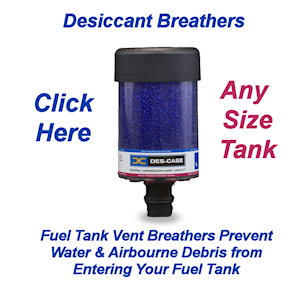Cleaning Base Tanks Using The
Multi-Point Flowpath System
FPS LX-F with TSC-7000
Touchscreen Controller
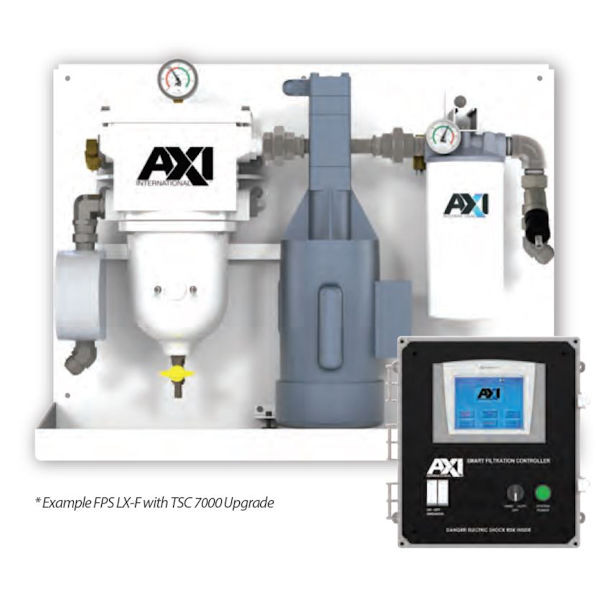
The Multi-Point Flowpath Actuated Valve System allows for fuel movement within each compartment & between compartments to promote the fuel tank cleaning process where obstructions otherwise prevent freedom of flow.
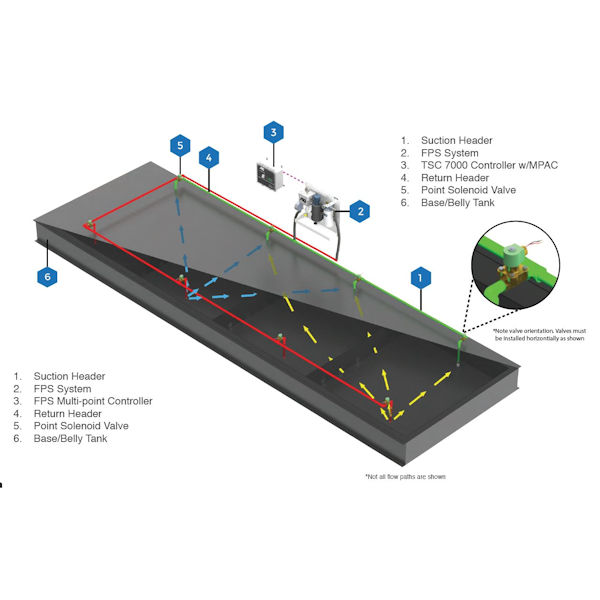
Multi-Point Valve
Controller Operation
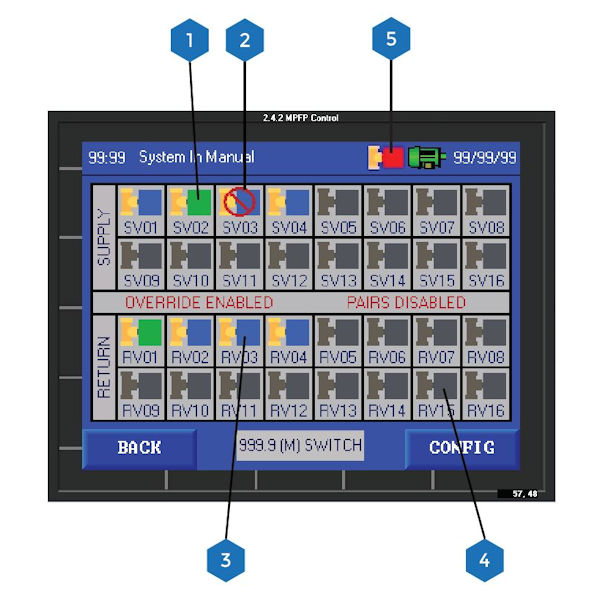
- Green shows which supply and return valve is active
- Red cross-out shows that the valve has a failure
- Blue shows that the valve is not currently active
- Grey shows that the valve is not available
- Valve failure indicator
Multi-Point Flowpath
Solenoid Valves
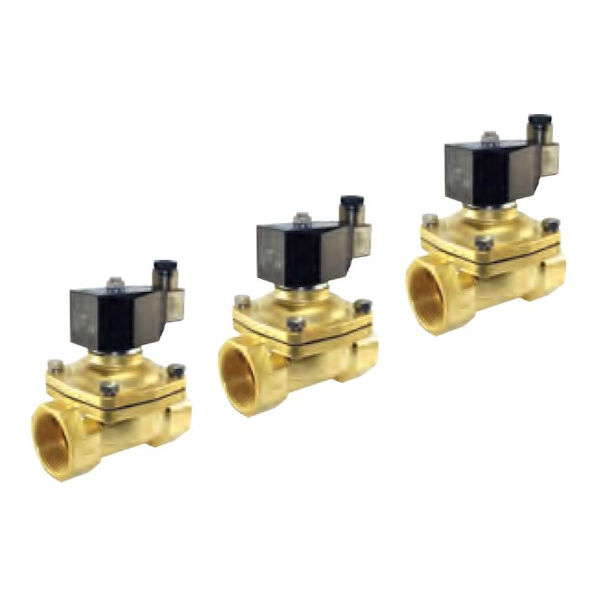
Frequently Asked
Questions
It is not unusual that a Fuel Polishing and Tank Cleaning System is installed at a level above the fuel that is to be maintained, especially in underground tanks or base (or “belly”) tanks of generators. How do you maintain the prime on the pump in such an installation?
 Foot Valves are handy little devices that can be installed at the end of a pipe line in a suction lift application. They function as a check valve to maintain the prime and also have a strainer affixed to the open end. The check valve is spring assisted. When the pump is turned on, the suction opens the valve and the fluid flows. When the pump stops, the valve responds again by closing. This stops fluid from draining out of the pump column and causing the pump to lose prime every time it turns off.
Foot Valves are handy little devices that can be installed at the end of a pipe line in a suction lift application. They function as a check valve to maintain the prime and also have a strainer affixed to the open end. The check valve is spring assisted. When the pump is turned on, the suction opens the valve and the fluid flows. When the pump stops, the valve responds again by closing. This stops fluid from draining out of the pump column and causing the pump to lose prime every time it turns off.
The strainer also keeps debris from becoming lodged in the foot valve. This would result in the valve being stuck in the open position, and all the fluid draining from the pump column. That nullifies the point of the foot valve! Some foot valves offer tight mesh, others offer a wider grid strainer.
Any installation of a Fuel Maintenance System dedicated to the cleaning and conditioning of fuel in one or multiple tanks would benefit from the inclusion of a foot valve. The efficiency of a system that is programmed to operate on a periodic basis would suffer if an operator must prime the pump each time a tank is due for maintenance.
The Multi-Port Flowpath Actuated Valve System is available to operate in unison with several of the FPS Fuel Polishing Systems. Each MP-VS Valve Set includes two (2) Solenoid Valves (one for the suction and one for the discharge line) and one Foot Vale to be installed on the end of the suction pipe. One valve set is typically installed in each partitioned section of the base tank.
Intelligent Actuated Valve Fuel Flow Control
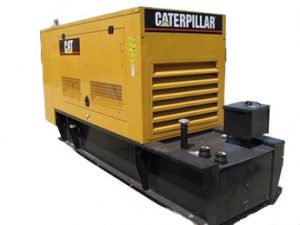
The Multi-Point Flow Path Package is an add-on option that enables the cleaning of base (or “belly”) tanks that have internal structural supports incorporated into the tanks to provide support for a top-mounted generator housing. The following FPS Series Compact Systems are compatible for use with the Multi-Point Flow Path System with certain add-on components:
- SX-F — 150 GPH for tanks up to 2,000 gallons
- MX-F — 240 GPH for tanks up to 6,000 gallons
- LX-F — 600 GPH for tanks up to 15,000 gallons
These Fuel Polishing and Tank Cleaning Systems are well suited for installations that service sub-base rectangular steel tanks (often referred to as “belly tanks”) typically utilized with diesel fuel powered generator installations configured with the generator mounted on top of the fuel tank. These types of base tanks are constructed with double walls, an area for spill containment, and have internal supports at the mounting points where the generator is connected to the tank. These internal supports often act as fuel baffles within the tank, creating compartments with holes in the supports/baffles that allow the diesel fuel to flow between the compartments.
Cylindrical vs. Base Tank Fuel Polishing
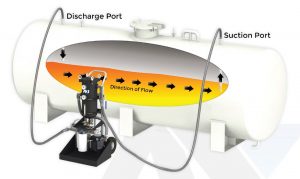
In the process of circulating fuel for the purpose of filtering, conditioning and polishing the fuel contained in a typical cylindrical tank, the process involves placing the suction hose in a port near one end of the tank, typically the low point so as to suction water and sludge that would accumulate at the low end of the tank. The discharge hose would be inserted at the opposite end of the tank, sometimes configured with fittings that would encourage the discharge flow to direct debris and sludge that may be along the bottom of the tank to the low end of the tank to be picked up by the suction hose. With the cylindrical tank shape, the debris and sludge would typically collect along the bottom in an easy to reach narrow path allowing the fuel flow to push the debris along this path. See the picture at the left that shows how an MTC Series Mobil Tank Cleaning (cart mounted) MTC-X System might be set up to perform a tank cleaning and fuel maintenance operation.
A rectangular flat tank (a base tank or belly tank) is usually configured as a base to a generator enclosure, an example of which is pictured to the right (the lower portion, the fuel tank, is painted black). The base tank could hold as little as 400 gallons or as much as 4,000 gallons and can measure up to 20 feet long, 6 feet wide and 5 feet high. The internal compartments are formed with structural supports that result in baffles and the compartmentalization presents restrictions to fuel flow if the only access is at either end of the base tank. The flat nature of the tank bottom allows debris to be spread out over the entire base of the tank. Also, there may not be a “low point” in the tank, so water may be spread out over the entire tank bottom.
Using Multiple Suction and Discharge Points to Clean a Flat Tank Bottom

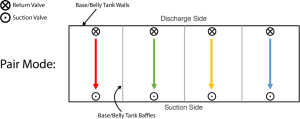
Multi-Path Tank Cleaning
The Multi-Point Flow Path System provides a means of ensuring optimal fuel quality for restrictive tanks containing multiple internal obstructions. Structural baffles and internal configurations can present issues for fuel path travel, leaving areas susceptible to the collection of water, sediment, and bio-accumulation. By adding multiple suction and discharge points within the tank at locations so that a suction and discharge valve is located in each compartment, new flow paths are created that can push out fuel tank sludge, particulate materials & debris, and other forms of contamination from hard to reach sections of the tank. In addition, the fuel re-circulation process performs fuel polishing maintaining the clear & bright appearance of fuel. This process, unique to AXI, is the most effective way to ensure optimal fuel quality for fuel tanks constructed with structural components and/or baffles.
The Multi-point Flow Path package works through random valve actuation on both the discharge/supply and return/suction plumbing. Depending on the tank configuration, the Multi-point solenoid valves can be installed throughout the tank, providing multiple, varying flow paths. Multi-point systems can control up to sixteen sets of solenoid valves per tank (32 total). The number of valves will determine the number of possible flow paths.
FPS Fuel Polishing System Upgraded Controller
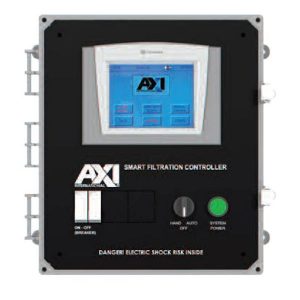
TSC Touch Screen Controller
with Programmable Multi-Point
Valve Control
The Multi-point Flow Path package necessitates the upgrade of the standard FPS System Controller offered on the FPS SX-F (2.5 GPM), FPS MX-F (4 GPM), or FPS LX-F (10 GPM) System to the TSC 7000 LCD Touchscreen/PLC Controller, which includes Modbus RTU/TC/IP and BACnet Capability. The TSC 7000 series controller is an HMI PLC UL508A controller with more intuitive system setup and monitoring from remote locations. The TSC-7000 Touch Screen Advanced Filtration Controller features the following:
- Modbus, TCP/IP, LAN and Internet Connectivity
- E-Mail & SMS Maintenance Alerts
- Maintenance Alert Log File
- Multiple Tank Functionality
- Runtime Totalizer
- Alarm History
- On-Screen Help
For safe operation, FPS systems are equipped with an automatic pump shut-down and indicators when filter elements require service. Also included are indicators for high pump vacuum, pressure exits, and leaks detection.
Order the TSC 7000 Upgrade at the same time as you place your order for the FPS System. If your installation necessitates mounting the FPS System outside, a separate enclosure is available by special order, but many generator enclosures have sufficient space available to mount the FPS System, as well as the TSC-MPAC Alternation Controller inside the generator enclosure.
TSC-MPAC Alternation Controller

MPAC Controller
Executes Programmed Sequence
Actuator Valves
The Multi-point Alternation Controller (the “MPAC”) interacts with the TSC 7000 Controller. The MPAC can control up to sixteen suction valves and sixteen discharge valves. There must be at least two suction and two discharge valves, and the system does not require an equal number of suction and discharge valves. Ideally, one suction and one discharge would be installed in each compartment of the fuel tank. The MPAC can control the sequence of the suction and discharge valves based on a random activation of supply and random return of valves per each time period set by the user. Alternately, the system may be set to operate in pair mode to clean one compartment at a time, with each pair be activated randomly. Non-pair mode allows the system to randomly choose any supply and any return valve for operation for the specified period.
Each valve is monitored for failure and will shut down pump upon failure. Valve failure will alert via alarm message and choose next available valve option. Operator may set override mode to manually activate or deactivate a supply or return valve.
The TSC Multi-Point Alternation Controller is ordered separately and includes software. If outside mounting of the MPAC is necessary, enclosures are available by special order.
Ordering the Multi-Point Flowpath for Your Facilities
Each installation of the Multi-Point Flowpath System involves a bit of customization based on the customer’s needs. First, choose the FPS unit that suits the size of your fuel tank. For tanks up to 2000 gallons, the FPS SX-F is sized for your tank. Tanks up to 6,000 gallons should use the FPS MX-F, and up to 15,000 gallons should use the FPS LX-F.
Each periodic fuel re-circulation should be performed with a full tank of fuel and requires the cycling of the fuel three times. Although the FPS SX-F, operating at 150 Gallons Per Hour can circulate the fuel in a 15,000 gallon tank three times in 300 hours of continuous operation, the operating life of the FPS SX-F will be shortened considerably. The FPS LX-F, on the other hand, can do it in 1/4 the time. It is best to chose the FPS unit to meet your tank size demands.
Choosing a FPS System that is larger than your needs will do no harm to the system. Some Fuel Management Programs where generators are used on a regular basis stipulate that new fuel added to a tank be put through the fuel polishing process as soon as and as quickly as possible to prevent new fuel from contaminating existing fuel. Having a larger system than normally recommended provides a great deal of benefits in a high fuel turnover situation.
The TSC-7000 Touch Screen Controller can be added when purchasing the FPS system that matches your demand, but an existing compatible FPS system can also be upgraded to use the Multi-point Flowpath System.
The TSC-MPAC Actuation Valve Controller requires a minimum of four (4) N.C. 24DC Solenoid Valves (no valves are included in this package and must be purchased separately according to your tank requirements) and requires the TSC 7000 Controller to operate (purchased separately as described above).
The MP-VS Valve Set includes two (2) Solenoid Valves and one Foot Valve. One set is required for each partitioned portion of the base bank. If there are six partitions, then six sets of valves (a total of twelve) are recommended (the foot valve is installed on the suction valve).
